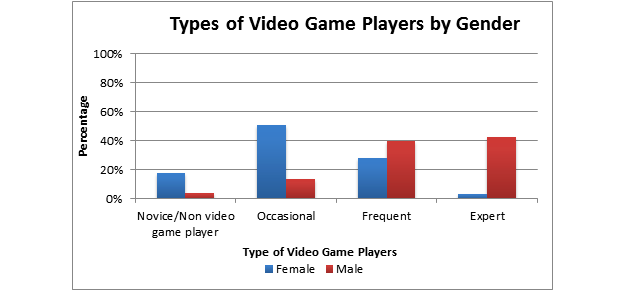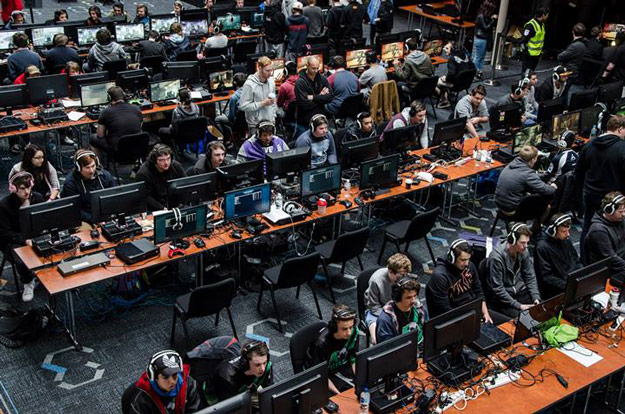Anyone involved in serious discussion about gaming will often hear that “almost 50% of gamers are female”. Anyone actually involved in gaming will quite simply say “bullshit”. In this article I’m going to dismantle some demographic myths perpetuated over and over again. Next time someone gives you a misleading statistic, link them to this article and perhaps you’ll educate them.
I’m not writing this to discourage women in gaming and I would love more representation of women in gaming. I’m writing this because I don’t believe lying is ok (whether accidental or intentional) and I believe people should be more informed and critical of the information they read on the internet. Don’t trust everything you read – Including this article you’re reading right now. Do your own research and form your own opinions.
What is a gamer?
Before we begin, I think it’s important we classify exactly what a “gamer” is. In my opinion, I believe it’s dishonest to call someone a gamer unless gaming is one of their primary hobbies. I played football when I was younger but I don’t call myself a football player. I’ve been fishing but I wouldn’t label myself a fisherman.
Unless you want to label me as a chef for cooking 2 Minute Noodles I wouldn’t call someone who plays Farmville and other Facebook games for 15 minutes a day a gamer.
Does anyone honestly think comparing a 16 year old boy playing Call of Duty for 10 hours a day versus a mother playing Facebook games in between reading emails is fair? They’re completely different. Labeling them both as “gamers” is dishonest.

I believe it’s important to differentiate between hardcore gamers and casual gamers. – Source
These “gamer” studies are all intentionally misleading because it leads advertisers to believe they are reaching more people than they actually are and that the main gaming demographic more diverse than you’d think which makes the gaming industry look more “mature”.
Now some may say, “who are you to say who is a gamer and who isn’t”. That’s a good question. I believe if you’re honest with yourself you’ll agree that putting casual gamers and hardcore gamers in the same category is absurd. They are 2 completely different markets and completely different demographics.
xX_1337_Sn1p3r_Xx isn’t going to waste his time playing Candy Crush when he could be unlocking prestige mode in Call of Duty and the average 40 year old mother will be lucky if she can work out how to even move the character using an Xbox control (Trust me on this – I’ve tried).
Entertainment Software Association
This is a yearly study done on the gaming industry where it seems most people get these statistics from. You can see it for yourself: 2013 – SALES, DEMOGRAPHIC AND USAGE DATA
Notice something about this? There is no mention of what they consider a “gamer”. My guess is anyone who EVER plays a game is a gamer in their eyes.
If you go to the section: Types of online games played most often – You will see that Puzzle, Board Game, Game Show, Trivia and Card Games are at the top of the chart with 34%. Casual and Social Games are 19%. That’s 53% of the study right there that the ESA considers “gamers” which no real gamer would agree with.

“Gamers” apparently.
If you’re going to call those who play social games “gamers”, you might as well just say 50% of the human population are women.
Even if the ESA didn’t intentionally make these statistics misleading themselves, they’ve failed to differentiate gamers and casual gamers and their study is frequently used out of context to push agendas.
Gaming patterns by gender
This study from the Software Usability Research Laboratory (SURL) at Wichita State University gives us an idea of how each gender plays games.
“Males were more likely than females to be drawn to games from the Strategy, Role Playing, Action, and Fighting genres whereas females were more likely than males to play games from the Social, Puzzle/Card, Music/Dance, Educational/Edutainment, and Simulation genres. Overall, more males than females treated video game playing as their primary hobby, while females viewed playing video games as less important than other hobbies such as watching television.”

As you can clearly see, despite being open to anyone, male players dominate the eSports scene.
If you read the rest of the study you will see that the average male plays far more video games than the average female. You’ll also see that many males considered themselves hardcore gamers while a very small percentage of females considered themselves “Experts”.
Results from a series of Multiple Mann-Whitney U tests showed that more male gamers tended to play video games at all times (i.e., during the day, weekends, and evenings) than female gamers. In comparison to female gamers, male gamers were more likely to indicate that gaming was immersive and that they preferred non-physically interactive games. Male gamers were also more likely than female gamers to indicate that they played games for long periods of time, disliked interruptions while gaming, thought of gaming as their main hobby, and spent more time gaming than watching TV or doing household chores.
While this study definitely takes a small population sample, the difference in data between genders is simply too great to ignore and reality appears to reflect this.
Theory versus reality
Anyone who has ever played online games can tell you immediately that girl gamers do not make up even close to half the gaming population.

Either this statistic is wrong or every single girl gamer doesn’t own an Xbox Live mic.
From my experience, World of Warcraft seems to have the highest female population ratio. I would estimate about 10% of WoW players are women. Play a game like Call of Duty or Halo however and it’s easily less than 5%. (NOTE: These are estimates based on my experience, I do not have reliable statistics to back up my claim)
Go to a video game tournament and quite often you’ll be able to count the amount of woman in attendance on one hand out of hundreds of attendees.
Pushing agendas
Statistics are an incredible tool. They are also easy to lie and mislead with. Many people do not question the accuracy of statistics. After all, we all know 88% of statistics are made up, right?
The problem with statistics is they don’t tell the whole story and they often lack context. As we can see, the ESA labels almost anyone as a “gamer” provided they’ve played Farmville at least once in their life.
Time and time again I read articles arguing for equal representation of women in AAA games. The problem is, in reality many women simply aren’t interested in these games even if they did have a lead female character. Just because women like playing Bejeweled doesn’t mean they’re going to go out and purchase the latest Assassins Creed just because it has playable female characters in it.

From Jezebel *groan* – Just one of many examples of bloggers arguing for more female protagonists in gaming ignoring the fact that the majority only play casual games – Source
The very same studies they cite in order to prove that half of the gaming population are female also show that the female population is more interested in playing casual games – Except they conveniently forget to ignore this fact. Funny that, isn’t it? Could that be because they know the statistics they’re citing are misleading?
Think about it. Does anyone honestly think publishers like Activision hate women so much that they intentionally exclude them just because they’re dicks? Of course not. Even if Activision did hate women I’m pretty sure their desire to make money would overwrite that.
If anyone knows how to market a game it’s Activision and I’m pretty sure they have a better idea of how to sell games and exactly who is buying their games than some random internet bloggers crying that Call of Duty doesn’t feature a playable woman in the campaign missions.
Sexism in gaming
Too many times I’ll read that gaming is a boys only club, girls are pushed away and game developers are expected to aim more games towards women. Why? It’s obvious that despite these claims that gamers are made up of almost 50% women, that the vast majority of women simply don’t show the same interest in games as men.

Australian Cyber League‘s Starcraft 2 caster duo Zepph and Maynarde. Zepph shows that anyone is welcome into the eSports scene.
There are definitely girl gamers out there. I would know since I’m married to one.
I don’t want gaming to be a boys only club and I’ll encourage girls to join the eSports scene at every opportunity I get. What I won’t support is misleading statistics, especially when these statistics are taken out of context in order to further someones agenda.

Lucky you to get a girl gamer for a wife.
I couldn’t agree more. I’m writing a paper about Alice: Madness Returns, and trying to situate the game in the supposed audience, I stumbled upon the ESA’s numbers. They didn’t seem right at all… I even went to PAX East this year and sat in on a panel about women in gaming. I mean really? You want to count women who play Trivia Crack as “gamers?” Definitely trying to push an agenda.
Social networks online massively skew female, the charts are missing engagement levels but I’m willing to bet that would skew it even further.
That I bet accounts for the missing demo.
Thank you for this. I found those stats very dubious.
Yeah, it is pretty obvious that certain people are only looking for reasons to complain about things that are not an issue
Pingback: Project Target Audience
Nailed it.
I could literally hug you for this. Thank you so much for this, bud.